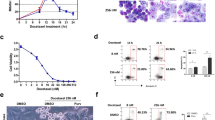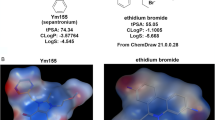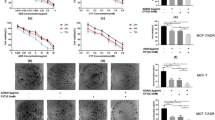Abstract
Although both the antiapoptotic function of survivin and vitamin D3 (VD3)-mediated cell growth inhibition and apoptosis have been extensively studied, it is not known whether survivin plays a role in VD3 compound-mediated cell growth inhibition and apoptosis induction. Using an isogenic model of MCF-7 breast adenocarcinoma cells (MCF-7E and MCF-7L sublines that are sensitive and resistant to VD3 compounds), we found that VD3 compounds effectively downregulated survivin in VD3-sensitive MCF-7E cells, which was associated with VD3-induced apoptosis. In contrast, VD3 compounds failed to downregulate survivin in VD3-resistant MCF-7L cells, which showed resistant to VD3-induced apoptosis. However, inhibition of survivin expression by small interfering RNA (siRNA) induced cell death per se and further sensitized VD3-induced apoptosis in MCF-7L cells, indicating that the inability of these cells to respond to VD3 is due to the failure to downregulate survivin. Forced expression of survivin not only blocked VD3-mediated G1 cell accumulation but also increased S and G2/M cell populations. VD3 treatment rapidly triggered the activation of p38 MAPK signaling in MCF-7E cells but not in MCF-7L cells. Moreover, inhibition of p38 activation diminished VD3-mediated survivin inhibition and partially rescued VD3-induced cell death. We further showed that VD3 increased the expression of TGFβ1 and TGFβ receptor 2, and that blocking the function of TGFβ receptor 2 diminished VD3 compound-mediated survivin downregulation. Thus, we propose that the VD3 compound-induced growth inhibition and apoptosis induction are at least partially dependent on survivin downregulation via VD3-induced TGFβ signaling and the activation of p38 MAPK pathway. Targeting survivin through these pathways may lead to novel applications for cancer therapeutics.
This is a preview of subscription content, access via your institution
Access options
Subscribe to this journal
Receive 50 print issues and online access
$259.00 per year
only $5.18 per issue
Buy this article
- Purchase on Springer Link
- Instant access to full article PDF
Prices may be subject to local taxes which are calculated during checkout











Similar content being viewed by others
Abbreviations
- IAP:
-
inhibitor of apoptosis
- BIR:
-
baculovirus IAP repeat
- VD3:
-
vitamin D3
- PARP:
-
poly (ADP-ribose) polymerase
- TGFβ RII:
-
transforming growth factor receptor II
- TGFβ DNR II:
-
dominant-negative TGFβ receptor 2
- siRNA:
-
small interfering RNA
- DOX:
-
doxycycline
- SDS-PAGE:
-
sodium dodecyl sulfate-polyacrylamide gel electrophoresis
- GAPDH:
-
glyceraldehyde 3-phosphate dehydrogenase
- PI:
-
propidium iodide
- s.d.:
-
standard deviation
References
Ambrosini G, Adida C and Altieri DC . (1997). Nat. Med., 3, 917–921.
Attisano L and Wrana JL . (2000). Curr. Opin. Cell Biol., 12, 235–243.
Blutt SE, Polek TC, Stewart LV, Kattan MW and Weigel NL . (2000). Cancer Res., 60, 779–782.
Chantalat L, Skoufias DA, Kleman JP, Jung B, Dideberg O and Margolis RL . (2000). Mol. Cell., 6, 183–189.
Chen J, Wu W, Tahir SK, Kroeger PE, Rosenberg SH, Cowsert LM, Bennett F, Krajewski S, Krajewska M, Welsh K, Reed JC and Ng SC . (2000). Neoplasia, 2, 235–241.
Chen Z, Naito M, Hori S, Mashima T, Yamori T and Tsuruo T . (1999). Biochem. Biophys. Res. Commun., 264, 847–854.
Choi KS, Lee TH and Jung MH . (2003). Cancer Gene Ther., 10, 87–95.
Colston KW, Chander SK, Mackay AG and Coombes RC . (1992). Biochem. Pharmacol., 44, 693–702.
Deveraux QL and Reed JC . (1999). Genes Dev., 13, 239–252.
Diaz GD, Paraskeva C, Thomas MG, Binderup L and Hague A . (2000). Cancer Res., 60, 2304–2312.
Duckett CS, Nava VE, Gedrich RW, Clem RJ, Van Dongen JL, Gilfillan MC, Shiels H, Hardwick JM and Thompson CB . (1996). EMBO J., 15, 2685–2694.
Edlund S, Bu S, Schuster N, Aspenstrom P, Heuchel R, Heldin NE, ten Dijke P, Heldin CH and Landstrom M . (2003). Mol. Biol. Cell, 14, 529–544.
Getzenberg RH, Light BW, Lapco PE, Konety BR, Nangia AK, Acierno JS, Dhir R, Shurin Z, Day RS, Trump DL and Johnson CS . (1997). Urology, 50, 999–1006.
Grossman D, McNiff JM, Li F and Altieri DC . (1999a). J. Invest. Dermatol., 113, 1076–1081.
Grossman D, McNiff JM, Li F and Altieri DC . (1999b). Lab Invest., 79, 1121–1126.
Hansen CM, Hamberg KJ, Binderup E and Binderup L . (2000). Curr. Pharm. Des., 6, 803–828.
Hershberger PA, Modzelewski RA, Shurin ZR, Rueger RM, Trump DL and Johnson CS . (1999). Cancer Res., 59, 2644–2649.
Hu PP, Datto MB and Wang XF . (1998). Endocr. Rev., 19, 349–363.
James SY, Mackay AG and Colston KW . (1996). J. Steroid Biochem. Mol. Biol., 58, 395–401.
James SY, Mercer E, Brady M, Binderup L and Colston KW . (1998). Br. J. Pharmacol., 125, 953–962.
Johnson CS, Hershberger PA and Trump DL . (2002). Cancer Metastasis Rev., 21, 147–158.
Kasof GM and Gomes BC . (2001). J. Biol. Chem., 276, 3238–3246.
Kawa S, Nikaido T, Aoki Y, Zhai Y, Kumagai T, Furihata K, Fujii S and Kiyosawa K . (1997). Br. J. Cancer, 76, 884–889.
Ko Y, Banerji SS, Liu Y, Li W, Liang J, Soule HD, Pauley RJ, Willson JK, Zborowska E and Brattain MG . (1998a). J. Cell Physiol., 176, 424–434.
Ko Y, Koli KM, Banerji SS, Li W, Zborowska E, Willson JKV, Brattain MG and Arteaga CL . (1998b). Int. J. Oncol., 12, 87–94.
Li F . (2003). J. Cell Physiol., 197, 8–29.
Li F, Ackermann EJ, Bennett CF, Rothermel AL, Plescia J, Tognin S, Villa A, Marchisio PC and Altieri DC . (1999). Nat. Cell. Biol., 1, 461–466.
Li F, Ambrosini G, Chu EY, Plescia J, Tognin S, Marchisio PC and Altieri DC . (1998). Nature, 396, 580–584.
Ling X and Li F . (2004). Bio.Tech., 36, 450–460.
Liston P, Roy N, Tamai K, Lefebvre C, Baird S, Cherton-Horvat G, Farahani R, McLean M, Ikeda JE, MacKenzie A and Korneluk RG . (1996). Nature, 379, 349–353.
Liu T, Brouha B and Grossman D . (2004). Oncogene, 23, 39–48.
Mathiasen IS, Lademann U and Jaattela M . (1999). Cancer Res., 59, 4848–4856.
Mesri M, Wall NR, Li J, Kim RW and Altieri DC . (2001). J. Clin. Invest., 108, 981–990.
Muchmore SW, Chen J, Jakob C, Zakula D, Matayoshi ED, Wu W, Zhang H, Li F, Ng SC and Altieri DC . (2000). Mol. Cell, 6, 173–182.
Narvaez CJ and Welsh J . (2001). J. Biol. Chem., 276, 9101–9107.
O’Connor DS, Grossman D, Plescia J, Li F, Zhang H, Villa A, Tognin S, Marchisio PC and Altieri DC . (2000). Proc. Natl. Acad. Sci. USA, 97, 13103–13107.
Olie RA, Simoes-Wust AP, Baumann B, Leech SH, Fabbro D, Stahel RA and Zangemeister-Wittke U . (2000). Cancer Res., 60, 2805–2809.
Padgett RW . (1999). Cancer Metastasis Rev., 18, 247–259.
Peehl DM, Skowronski RJ, Leung GK, Wong ST, Stamey TA and Feldman D . (1994). Cancer Res., 54, 805–810.
Pennati M, Colella G, Folini M, Citti L, Daidone MG and Zaffaroni N . (2002). J. Clin. Invest., 109, 285–286.
Reed JC and Reed SI . (1999). Nat. Cell. Biol., 1, E199–E200.
Richter BW, Mir SS, Eiben LJ, Lewis J, Reffey SB, Frattini A, Tian L, Frank S, Youle RJ, Nelson DL, Notarangelo LD, Vezzoni P, Fearnhead HO and Duckett CS . (2001). Mol. Cell. Biol., 21, 4292–4301.
Rothe M, Pan MG, Henzel WJ, Ayres TM and Goeddel DV . (1995). Cell, 83, 1243–1252.
Roy N, Mahadevan MS, McLean M, Shutler G, Yaraghi Z, Farahani R, Baird S, Besner-Johnston A, Lefebvre C, Kang X, Salih M, Aubry H, Tamai K, Guan X, Ioannou P, Crawford TO, de Jong PJ, Surh L, Ikeda J-E, Korneluk RG and MacKenzie A . (1995). Cell, 80, 167–178.
Salvesen GS and Duckett CS . (2002). Nat. Rev. Mol. Cell. Biol., 3, 401–410.
Schrantz N, Bourgeade MF, Mouhamad S, Leca G, Sharma S and Vazquez A . (2001). Mol. Biol. Cell., 12, 3139–3151.
Shankar SL, Mani S, O’Guin KN, Kandimalla ER, Agrawal S and Shafit-Zagardo B . (2001). J. Neurochem., 79, 426–436.
Shen C, Buck A, Polat B, Schmid-Kotsas A, Matuschek C, Gross HJ, Bachem M and Reske SN . (2003). Cancer Gene Ther., 10, 403–410.
Simboli-Campbell M, Narvaez CJ, Tenniswood M and Welsh J . (1996). J Steroid. Biochem. Mol. Biol., 58, 367–376.
Verdecia MA, Huang H, Dutil E, Kaiser DA, Hunter T and Noel JP . (2000). Nat. Struct. Biol., 7, 602–608.
Verlinden L, Verstuyf A, Convents R, Marcelis S, Van Camp M and Bouillon R . (1998). Mol. Cell. Endocrinol., 142, 57–65.
Vucic D, Stennicke HR, Pisabarro MT, Salvesen GS and Dixit VM . (2000). Curr. Biol., 10, 1359–1366.
Wu G, Fan RS, Li W, Ko TC and Brattain MG . (1997). Oncogene, 15, 1555–1563.
Wu G, Fan RS, Li W, Srinivas V and Brattain MG . (1998). J. Biol. Chem., 273, 7749–7756.
Xia C, Xu Z, Yuan X, Uematsu K, You L, Li K, Li L, McCormick F and Jablons DM . (2002). Mol. Cancer Ther., 1, 687–694.
Yang L, Yang J, Venkateswarlu S, Ko T and Brattain MG . (2001). J. Cell. Physiol., 188, 383–393.
Yoo J, Ghiassi M, Jirmanova L, Balliet AG, Hoffman B, Fornace Jr AJ, Liebermann DA, Bottinger EP and Roberts AB . (2003). J. Biol. Chem., 278, 43001–43007.
Yu L, Hebert MC and Zhang YE . (2002). EMBO J., 21, 3749–3759.
Zaffaroni N and Daidone MG . (2002). Drug Resist Update, 5, 65–72.
Acknowledgements
This work was sponsored in part by foundation grants from Wendy Will Case Cancer Fund Inc. (Chicago, IL), Elsa U Pardee Foundation (Midland, Michigan) and Concern Foundation (Beverly Hill, CA) to FL, by NIH R01 grants to MGB (CA72001 and CA38173) and to FL (CA109481), and by shared resources of NIH Cancer Center Support Grant (CA16056) to Roswell Park Cancer Institute.
Author information
Authors and Affiliations
Corresponding author
Rights and permissions
About this article
Cite this article
Li, F., Ling, X., Huang, H. et al. Differential regulation of survivin expression and apoptosis by vitamin D3 compounds in two isogenic MCF-7 breast cancer cell sublines. Oncogene 24, 1385–1395 (2005). https://doi.org/10.1038/sj.onc.1208330
Received:
Revised:
Accepted:
Published:
Issue Date:
DOI: https://doi.org/10.1038/sj.onc.1208330
Keywords
This article is cited by
-
The proto-oncogene survivin splice variant 2B is induced by PDGF and leads to cell proliferation in rheumatoid arthritis fibroblast-like synoviocytes
Scientific Reports (2015)
-
Preterm infants, kidney, rickets and vitamin D intake: is it time for rewriting the history?
Archives of Gynecology and Obstetrics (2014)



